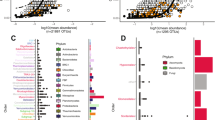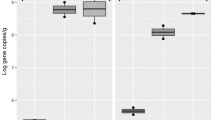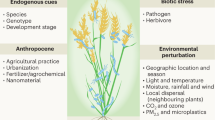Abstract
Microbial communities associated with plant leaf surfaces (i.e., the phyllosphere) are increasingly recognized for their role in plant health. While accumulating evidence suggests a role for host filtering of its microbiota, far less is known about how community composition is shaped by dispersal, including from neighboring plants. We experimentally manipulated the local plant neighborhood within which tomato, pepper, or bean plants were grown in a 3-month field trial. Focal plants were grown in the presence of con- or hetero-specific neighbors (or no neighbors) in a fully factorial combination. At 30-day intervals, focal plants were harvested and replaced with a new age- and species-matched cohort while allowing neighborhood plants to continue growing. Bacterial community profiling revealed that the strength of host filtering effects (i.e., interspecific differences in composition) decreased over time. In contrast, the strength of neighborhood effects increased over time, suggesting dispersal from neighboring plants becomes more important as neighboring plant biomass increases. We next implemented a cross-inoculation study in the greenhouse using inoculum generated from the field plants to directly test host filtering of microbiomes while controlling for directionality and source of dispersal. This experiment further demonstrated that focal host species, the host from which the microbiome came, and in one case the donor hosts’ neighbors, contribute to variation in phyllosphere bacterial composition. Overall, our results suggest that local dispersal is a key factor in phyllosphere assembly, and that demographic factors such as nearby neighbor identity and biomass or age are important determinants of phyllosphere microbiome diversity.
Similar content being viewed by others
Log in or create a free account to read this content
Gain free access to this article, as well as selected content from this journal and more on nature.com
or
References
Lindow SE, Brandl MT. Microbiology of the phyllosphere. Appl Environ Microbiol. 2003;69:1875LP–1883.
Morella NM, Zhang X, Koskella B. Tomato seed-associated bacteria confer protection of seedlings against foliar disease caused by Pseudomonas syringae. Phytobiomes J. 2019;3:177–90.
Innerebner G, Knief C, Vorholt JA. Protection of Arabidopsis thaliana against leaf-pathogenic Pseudomonas syringae by Sphingomonas strains in a controlled model system. Appl Environ Microbiol. 2011;77:3202–10.
Fu S-F, Sun P-F, Lu H-Y, Wei J-Y, Xiao H-S, Fang W-T, et al. Plant growth-promoting traits of yeasts isolated from the phyllosphere and rhizosphere of Drosera spatulata Lab. Fungal Biol. 2016;120:433–48.
Laforest-Lapointe I, Paquette A, Messier C, Kembel SW. Leaf bacterial diversity mediates plant diversity and ecosystem function relationships. Nature. 2017;546:145–7.
Lindow SE, Leveau JHJ. Phyllosphere microbiology. Curr Opin Biotechnol. 2002;13:238–43.
Fürnkranz M, Wanek W, Richter A, Abell G, Rasche F, Sessitsch A. Nitrogen fixation by phyllosphere bacteria associated with higher plants and their colonizing epiphytes of a tropical lowland rainforest of Costa Rica. ISME J. 2008;2:561–70.
Ottesen AR, Gorham S, Reed E, Newell MJ, Ramachandran P, Canida T, et al. Using a control to better understand phyllosphere microbiota. PLoS ONE. 2016;11:e0163482.
Jones JDG, Dangl JL. The plant immune system. Nature. 2006;444:323–9.
Bodenhausen N, Bortfeld-miller M, Ackermann M, Vorholt JA. A synthetic community approach reveals plant genotypes affecting the phyllosphere microbiota. PLoS Biol. 2014; 10. https://doi.org/10.1371/journal.pgen.1004283.
Horton MW, Bodenhausen N, Beilsmith K, Meng D, Muegge BD, Subramanian S, et al. Genome-wide association study of Arabidopsis thaliana leaf microbial community. Nat Commun. 2014;5:5320.
Hacquard S, Spaepen S, Garrido-Oter R, Schulze-Lefert P. Interplay between innate immunity and the plant microbiota. Annu Rev Phytopathol. 2017;55:565–89.
Zhalnina K, Louie KB, Hao Z, Mansoori N, Nunes U, Shi S et al. Dynamic root exudate chemistry and substrate preferences drive patterns in rhizosphere microbial community assembly. Nat Microbiol. 2018. https://doi.org/10.1038/s41564-018-0129-3.
Humphrey PT, Whiteman NK. Insect herbivory reshapes a native leaf microbiome. Nat Ecol Evol. 2020;4:221–9.
Yadav RKP, Karamanoli K, Vokou D. Bacterial colonization of the phyllosphere of Mediterranean perennial species as influenced by leaf structural and chemical features. Micro Ecol. 2005;50:185–96.
Morella NM, Weng FCH, Joubert PM, Metcalf CJE, Lindow S, Koskella B. Successive passaging of a plant-associated microbiome reveals robust habitat and host genotype-dependent selection. Proc Natl Acad Sci USA. 2020;117:1148–59.
Wagner MR, Busby PE, Balint-Kurti P. Analysis of leaf microbiome composition of near-isogenic maize lines differing in broad-spectrum disease resistance. N Phytol. 2019;225:2152–65.
Wagner MR, Lundberg DS, Del Rio TG, Tringe SG, Dangl JL, Mitchell-Olds T. Host genotype and age shape the leaf and root microbiomes of a wild perennial plant. Nat Commun. 2016;7:1–15.
Horner-Devine MC, Bohannan BJM. Phylogenetic clustering and overdispersion in bacterial communities. Ecology. 2006;87:S100–8.
Kembel SW, O’Connor TK, Arnold HK, Hubbell SP, Wright SJ, Green JL. Relationships between phyllosphere bacterial communities and plant functional traits in a neotropical forest. Proc Natl Acad Sci USA 2014; 1–6.
Burns AR, Stephens WZ, Stagaman K, Wong S, Rawls JF, Guillemin K, et al. Contribution of neutral processes to the assembly of gut microbial communities in the zebrafish over host development. ISME J. 2016;10:655–64.
Sloan WT, Woodcock S, Lunn M, Head IM, Curtis TP. Modeling taxa-abundance distributions in microbial communities using environmental sequence data. Micro Ecol. 2007;53:443–55.
Laforest-Lapointe I, Messier C, Kembel SW. Host species identity, site and time drive temperate tree phyllosphere bacterial community structure. Microbiome 2016; 1–10.
Schlaeppi K, Dombrowski N, Oter RG, Ver Loren van Themaat E, Schulze-Lefert P. Quantitative divergence of the bacterial root microbiota in Arabidopsis thaliana relatives. Proc Natl Acad Sci USA. 2014;111:585LP–592.
Gallart M, Adair KL, Love J, Meason DF, Clinton PW, Xue J, et al. Host genotype and nitrogen form shape the root microbiome of Pinus radiata. Micro Ecol. 2018;75:419–33.
Hambäck PA, Inouye BD, Andersson P, Underwood N. Effects of plant neighborhoods on plant–herbivore interactions: resource dilution and associational effects. Ecology. 2014;95:1370–83.
Underwood N, Inouye BD, Hambäck PA. A conceptual framework for associational effects: when do neighbors matter and how would we know? Q Rev Biol. 2014;89:1–19.
Barbosa P, Hines J, Kaplan I, Martinson H, Szczepaniec A, Szendrei Z. Associational resistance and associational susceptibility: having right or wrong neighbors. Annu Rev Ecol Evol Syst. 2009;40:1–20.
Janzen DH. Herbivores and the number of tree species in tropical forests. Am Nat. 1970;104:501–28.
Connell JH. On the role of natural enemies in preventing competitive exclusion in some marine animals and in rain forest trees. in Den Boer PJ, Gradwell G, editors. Dynamics of populations. PUDOC, 1971, p. 298–312.
Mangan SA, Schnitzer SA, Herre EA, Mack KML, Valencia MC, Sanchez EI, et al. Negative plant–soil feedback predicts tree-species relative abundance in a tropical forest. Nature. 2010;466:752–5.
Miller EC, Perron GG, Collins CD. Plant‐driven changes in soil microbial communities influence seed germination through negative feedbacks. Ecol Evol. 2019;0:1–14.
Antonovics J, Ellstrand NC. Experimental studies of the evolutionary significance of sexual reproduction. I. A test of the frequency-dependent selection hypothesis. Evolution. 1984;38:103–15.
Ellstrand NC, Antonovics J. Experimental studies of the evolutionary significance of sexual reproduction II. A test of the density-dependent selection hypothesis. Evolution. 1985;39:657–66.
Naeem S, Tjossem SF, Byers D, Bristow C, Li S. Plant neighborhood diversity and production. Ecoscience. 1999;6:355–65.
Worrich A, Musat N. Associational effects in the microbial neighborhood. ISME J 2019; 2143–9.
Copeland JK, Yuan L, Layeghifard M, Wang PW, Guttman DS. Seasonal community succession of the phyllosphere microbiome. Mol Plant Microbe Interact. 2015;28:274–85.
Lajoie G, Kembel SW. Host neighborhood shapes bacterial community assembly and specialization on tree species across a latitudinal gradient. Ecol Monogr. 2021;0:1–18.
Lymperopoulou D, Adams R, Lindow SE, Löffler F. Contribution of vegetation to the microbial composition of nearby outdoor air. Appl Environ Microbiol. 2016;82:3822–33.
Lindow SE, Andersen G. Influence of immigration on epiphytic bacterial populations on navel orange leaves. Appl Environ Microbiol. 1996;62:2978–87.
Massoni J, Bortfeld-miller M, Widmer A, Vorholt JA. Capacity of soil bacteria to reach the phyllosphere and convergence of floral communities despite soil microbiota variation. Proc Natl Acad Sci USA 2021; 118. https://doi.org/10.1073/pnas.2100150118.
Leibold MA, Holyoak M, Mouquet N, Amarasekare P, Chase JM, Hoopes MF, et al. The metacommunity concept: a framework for multi-scale community ecology. Ecol Lett. 2004;7:601–13.
Fodelianakis S, Lorz A, Valenzuela-cuevas A, Barozzi A, Booth JM, Daffonchio D. Dispersal homogenizes communities via immigration even at low rates in a simplified synthetic bacterial metacommunity. Nat Commun. 2019;10:1–12.
Burns AR, Miller E, Agarwal M, Rolig AS, Milligan-Myhre K, Seredick S et al. Interhost dispersal alters microbiome assembly and can overwhelm host innate immunity in an experimental zebrafish model. Proc Natl Acad Sci USA 2017;114. https://doi.org/10.1073/pnas.1702511114.
Chelius MK, Triplett EW. The diversity of archaea and bacteria in association with the roots of Zea mays L. Micro Ecol. 2001;41:252–63.
Bodenhausen N, Horton MW, Bergelson J. Bacterial communities associated with the leaves and the roots of Arabidopsis thaliana. PLoS ONE. 2013;8:e56329.
Lundberg DS, Yourstone S, Mieczkowski P, Jones CD, Dangl JL. Practical innovations for high-throughput amplicon sequencing. Nat Methods. 2013;10:999–1002.
Callahan BJ, McMurdie PJ, Rosen MJ, Han AW, Johnson AJA, Holmes SP. DADA2: high-resolution sample inference from Illumina amplicon data. Nat Methods. 2016;13:581.
R Core Team. R: A language and environment for statistical computing. 2020. http://cran.r-project.org.
Morgan M, Anders S, Lawrence M, Aboyoun P, Pagès H, Gentleman R. ShortRead: a bioconductor package for input, quality assessment and exploration of high-throughput sequence data. Bioinformatics. 2009;25:2607–8.
Pagès H, Aboyoun P, Gentleman R, DebRoy S. Biostrings: efficient manipulation of biological strings. 2020.
McMurdie P, Holmes S. phyloseq: An R package for reproducible interactive analysis and graphics of microbiome census data. PLoS ONE 2013; 8. https://doi.org/10.1371/journal.pone.0061217tle.
Wang Q, Garrity GM, Tiedje JM, Cole JR. Naive bayesian classifier for rapid assignment of rRNA sequences into the new bacterial taxonomy. Appl Environ Microbiol. 2007;73:5261–7.
Quast C, Pruesse E, Yilmaz P, Gerken J, Schweer T, Yarza P, et al. The SILVA ribosomal RNA gene database project: improved data processing and web-based tools. Nucleic Acids Res. 2013;41:D590–D596.
Davis NM, Proctor DM, Holmes SP, Relman DA, Callahan BJ. Simple statistical identification and removal of contaminant sequences in marker-gene and metagenomics data. Microbiome. 2018;6:226.
Morella NM, Gomez AL, Wang G, Leung MS, Koskella B. The impact of bacteriophages on phyllosphere bacterial abundance and composition. Mol Ecol. 2018;27:2025–38.
Oksanen J, Blanchet FG, Roeland K, Legendre P, Minchin P, O’Hara RB et al. vegan: Community ecology package. 2015. http://cran.r-project.org.
Anderson MJ. A new method for non-parametric multivariate analysis of variance. Austral Ecol. 2001;26:32–46.
De Cáceres M, Legendre P. Associations between species and groups of sites: indices and statistical inference. Ecology. 2009;90:3566–74.
Ersts PJ. Geographic Distance Matrix Generator. http://biodiversityinformatics.amnh.org/open_source/gdmg.
Sprockett D. reltools: Microbiome Amplicon Analysis and Visualization. 2021.
Sloan WT, Lunn M, Woodcock S, Head IM, Nee S, Curtis TP. Quantifying the roles of immigration and chance in shaping prokaryote community structure. Environ Microbiol. 2006;8:732–40.
Wright ES. Using DECIPHER v2.0 to analyze big biological sequence data in R. R J. 2016;8:352–9.
Schliep KP. phangorn: phylogenetic analysis in R. Bioinformatics. 2011;27:592–3.
Kembel SW, Cowan PD, Helmus MR, Cornwell WK, Morlon H, Ackerly DD, et al. Picante: R tools for integrating phylogenies and ecology. Bioinformatics. 2010;26:1463–4.
Koskella B. The phyllosphere. Curr Biol. 2020;30:R1143–R1146.
Chaparro JM, Badri DV, Vivanco JM. Rhizosphere microbiome assemblage is affected by plant development. ISME J. 2014;8:790–803.
İnceoğlu Ö, Al-Soud WA, Salles JF, Semenov AV, van Elsas JD. Comparative analysis of bacterial communities in a potato field as determined by pyrosequencing. PLoS ONE. 2011;6:e23321.
Christian N, Herre EA, Mejia LC, Clay K. Exposure to the leaf litter microbiome of healthy adults protects seedlings from pathogen damage. Proc R Soc B Biol Sci. 2017;284:20170641.
Leigh EG, Davidar P, Dick CW, Terborgh J, Puyravaud J-P, ter Steege H, et al. Why do some tropical forests have so many species of trees? Biotropica. 2004;36:447–73.
Hyatt LA, Rosenberg MS, Howard TG, Bole G, Fang W, Anastasia J, et al. The distance dependence prediction of the Janzen-Connell hypothesis: a meta-analysis. Oikos. 2003;103:590–602.
Carson W, Anderson J, Leigh E, Schnitzer S. Challenges associated with testing and falsifying the Janzen_Connell hypothesis: a review and critique. In: Carson W, Schnitzer SA, editors. Tropical forest community ecology. Wiley Blackwell; 2008. p. 210–41.
Acknowledgements
We acknowledge that this work was conducted on the territory of xučyun (Huichin), the ancestral and unceded land of the Chochenyo-speaking Ohlone people; therefore this work would not have been possible were it not for their past land stewardship. We thank the staff of UC-Berkeley’s Oxford Tract Greenhouse for their assistance in maintaining the experiment. We thank M. Rolston at UC-Davis for his hard work during library preparation and sequencing. Thank you to R. Koutsoukis, T. Caro, X. Zhang, R. Debray, C. Hernandez, and E. Mehlferber for assistance with initial planting, and to the Koskella lab for invaluable feedback throughout. The study was funded by the US National Science Foundation, award No. 1754494.
Author information
Authors and Affiliations
Contributions
KMM, SEL, CJEM, and BK conceptualized and designed the experiments. KMM, RP, AV, JKS, and IEM performed the experiments and processed the samples. All authors contributed to the writing and editing of the paper.
Corresponding author
Ethics declarations
Competing interests
The authors declare no competing interests.
Additional information
Publisher’s note Springer Nature remains neutral with regard to jurisdictional claims in published maps and institutional affiliations.
Supplementary information
Rights and permissions
About this article
Cite this article
Meyer, K.M., Porch, R., Muscettola, I.E. et al. Plant neighborhood shapes diversity and reduces interspecific variation of the phyllosphere microbiome. ISME J 16, 1376–1387 (2022). https://doi.org/10.1038/s41396-021-01184-6
Received:
Revised:
Accepted:
Published:
Issue date:
DOI: https://doi.org/10.1038/s41396-021-01184-6
This article is cited by
-
Host selection is not a universal driver of phyllosphere community assembly among ecologically similar native New Zealand plant species
Microbiome (2025)
-
Reproducing plant microbiome research reveals site and time as key drivers of apple tree phyllosphere bacterial communities
Scientific Reports (2025)
-
mecoturn: An R package for deciphering microbial turnover patterns along gradients
Soil Ecology Letters (2025)
-
Plant invasion affects litter decomposition differently in native and invasive plant conditioned soils
Plant and Soil (2025)
-
Life on a leaf: the epiphyte to pathogen continuum and interplay in the phyllosphere
BMC Biology (2024)



